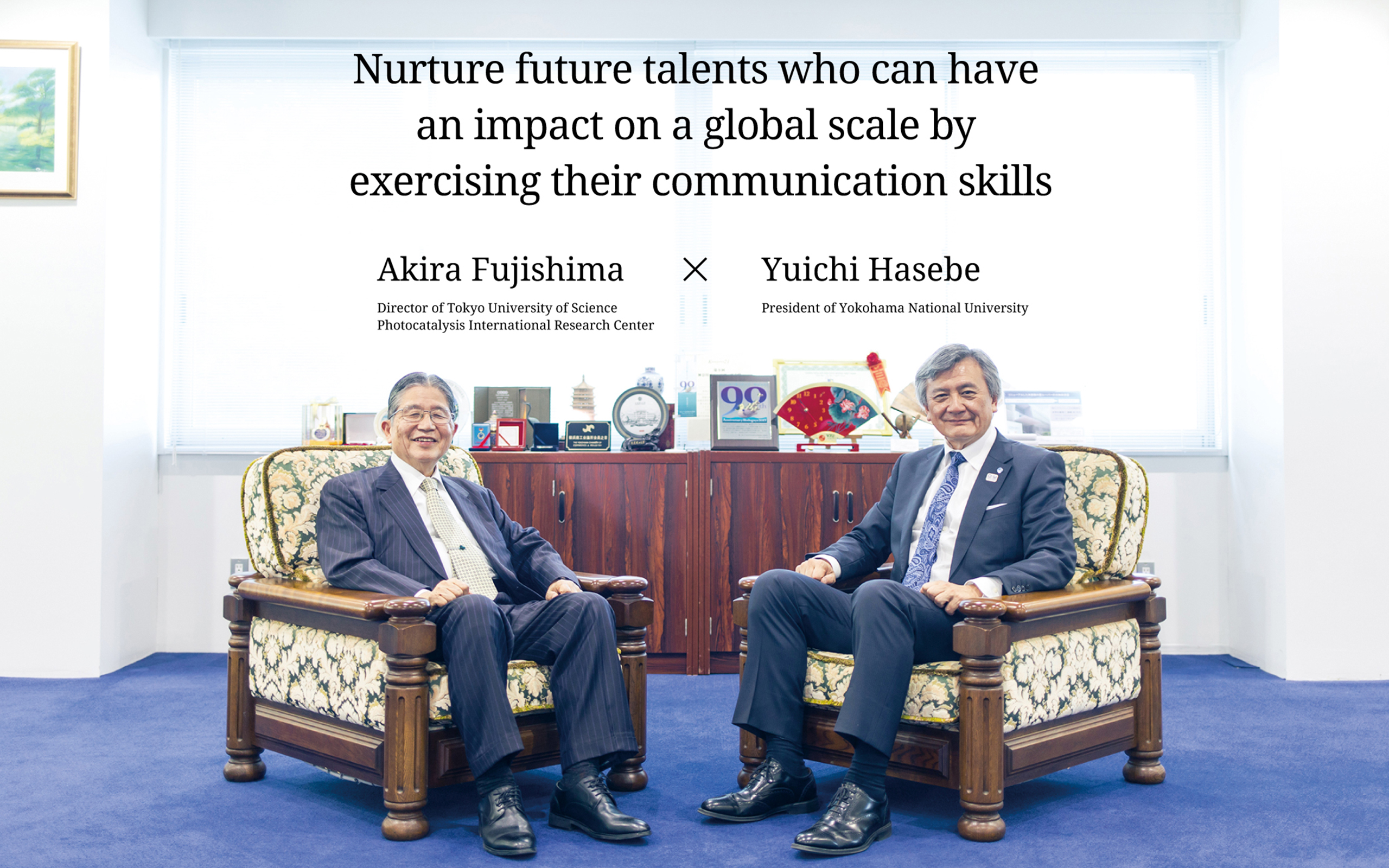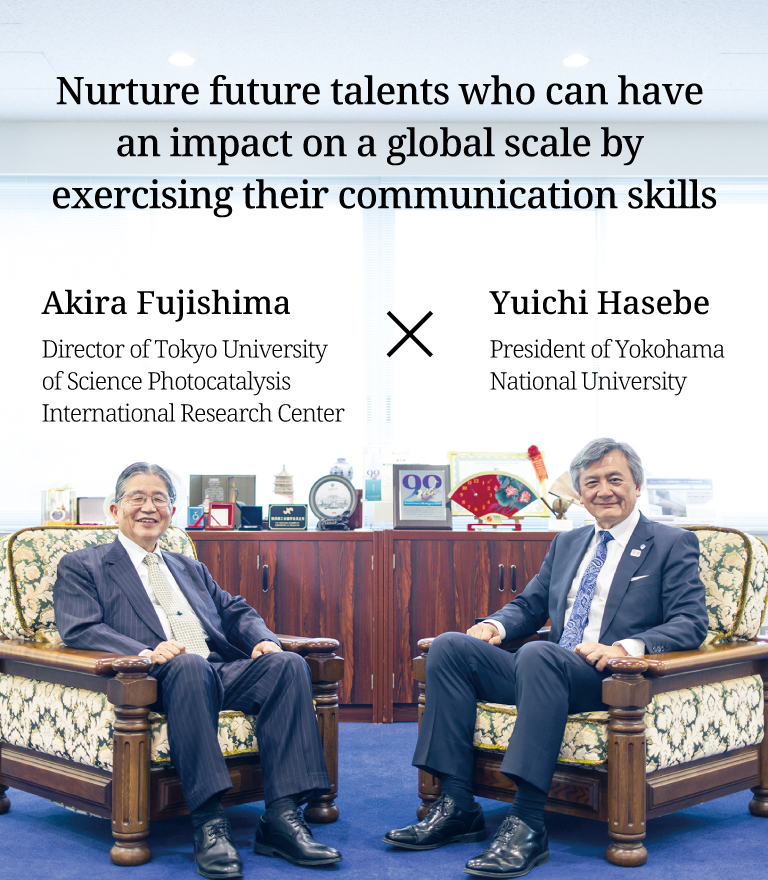-
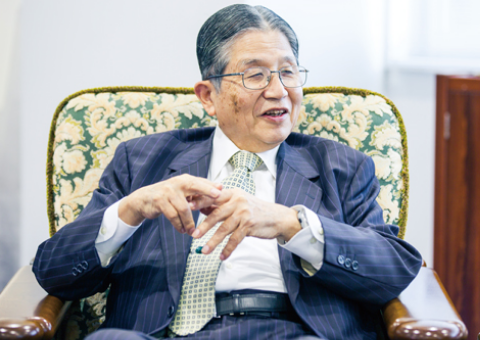
-
Akira Fujishima / Director of Tokyo University of Science Photocatalysis International Research Center
Akira Fujishima was born in 1942 in Tokyo. In 1966, he graduated from the Department of Electrochemistry Department of Electrical Engineering at the Faculty College of Engineering, Yokohama National University. Later, he served as a lecturer at Kanagawa University, a professor at the University of Tokyo, the ninth president of Tokyo University of Science, and so forth before assuming current positions as the director of the Photocatalysis Museum and the chairperson of Kawasaki Civic Academy, among others. He is a cultural contributor, a recipient of the Order of Culture, a honorary doctorate and the Proud Alumni of Yokohama National University. He specializes in photoelectrochemistry and functional materials chemistry. He discovered the phenomenon of photocatalytic water decomposition.
-

-
Akira Fujishima / Director of Tokyo University of Science Photocatalysis International Research Center
Akira Fujishima was born in 1942 in Tokyo. In 1966, he graduated from the Department of Electrical Engineering at the College of Engineering, Yokohama National University. Subsequently, he served as a lecturer at Kanagawa University, a professor at the University of Tokyo, the ninth president of Tokyo University of Science, and various other roles before assuming his current positions as the director of the Photocatalysis Museum and the chairperson of Kawasaki Civic Academy, among others. He is a cultural contributor, a recipient of the Order of Culture, an honorary doctorate recipient and the Proud Alumni of Yokohama National University. He specializes in photoelectrochemistry and functional materials chemistry. He discovered the phenomenon of photocatalytic water decomposition.
Taking the initiative as a motivated undergraduate student
Hasebe:Professor Fujishima could you tell us how you spent your years at YNU?
Fujishima:I vividly remember the “delivery lessons” that a few of my friends and I organized in the provinces during our sophomore and junior years. We wanted to be productive during our valuable summer vacations. To do so, we sent reply-paid cards to school boards in the provinces. They accepted our proposals to conduct a three-day special lesson for the students that gathered on their school grounds. I was in charge of science and my friends taught math and English. We cooked meals by ourselves while staying in the room for night duty and so forth. We stayed in the Sanin region in western Japan in our sophomore year. We travelled southward starting from Aomori in our junior year.
Hasebe:So basically, you found venues instead of waiting for invitations.
Fujishima:We had a can-do attitude. Referring to the popular analogy of a passing ambulance siren, I used to explain that the Doppler effect is similarly observed with light from stars. Red stars are usually moving away in the distance and blue stars are mostly in our vicinity.
Hasebe:You visit elementary and junior high schools today. But in fact, you have valued the education of children to build a better future ever since your college years, have you not? That kind of initiative combined with the Internet today would offer abundant opportunities for younger generations.
Fujishima:During one spring vacation, we organized a study camp at a guest house in Izu to read through both volumes of Quantum Mechanics written by Professor Shinichiro Tomonaga. We jogged every morning to spend the rest of the day just reading the book by the renowned Japanese physicist. After we finished, we spontaneously agreed: “Hey, let’s go to that island over there!” Luckily, we were thrifty enough to be able to afford a roundtrip on a boat to climb the mountain on Izu Oshima.
Hasebe:You had truly fulfilling college years.
Fujishima:We still maintain a close relationship ever since those days at YNU.
-
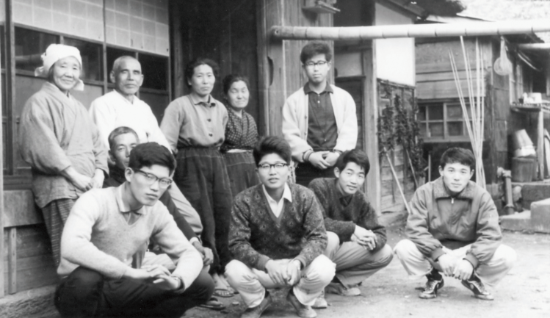
-
Mr. Fujishima (center) and other members from the Quantum Mechanicsstudy tour, along with the host family of a guest house in Mera, Izu.
-
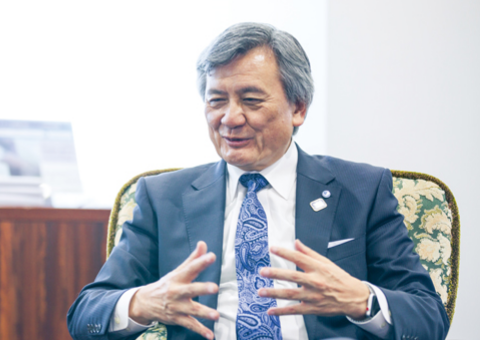
-
Yuichi Hasebe / President of Yokohama National University
Yuichi Hasebe was born in 1954 in Tokyo. In 1984, he was appointed an associate professor at the College of Economics, Yokohama National University. He became a professor there in 1996. Later, he continued to serve YNU as the Dean of the International Graduate School of Social Sciences, the Director of the Information Technology Service Center, and so on before assuming his current position in 2015. He specializes in comparative economic systems and input-output analysis.
-

-
Yuichi Hasebe / President of Yokohama National University
Yuichi Hasebe was born in 1954 in Tokyo. In 1984, he was appointed associate professor at the College of Economics, Yokohama National University. He became a professor there in 1996. Later, he continued to serve YNU as the Dean of the Graduate School of International Social Sciences, the Director of the Information Technology Service Center, and various other roles before assuming his current position in 2015. He specializes in comparative economic systems and input-output analysis.
Oil shock brought photocatalysis into the limelight
Hasebe: I hear you have struggled to gain an understanding for your later research on photocatalysis.
Fujishima:The principle of photocatalysis was shaped during the first and second years of my graduate studies at the University of Tokyo. The idea was to artificially reproduce photosynthesis that occurs on the surface of plant leaves. I managed to decompose water with photosensitive titanium dioxide in place of chlorophyll. But people just wouldn’t believe my presentations at scientific meetings. I had trouble earning my doctorate.
My paper was published in Nature, a prestigious British scientific journal. That was in 1972, a year before the oil crisis when I was a lecturer at Kanagawa University. Obviously, the decomposition of water produces both oxygen and hydrogen. That was why my research made the front page of a Japanese newspaper in 1974 with a headline along the lines of “a Japanese declares successful production of hydrogen on his own.” Then, finally, people began to believe me.
Hasebe:Thanks to the additional discovery of antibacterial effects, photocatalysis has widely been employed to address environmental issues to create a more comfortable living space.
Fujishima:Photocatalysis is already applied in practice around the world. For example, the technology is employed to eradicate bacteria from the floors and walls of hospitals, and to apply self-cleaning coating on external walls.
Hasebe: Indeed, photocatalysis is now established as a world-class clean technology from Japan.
-
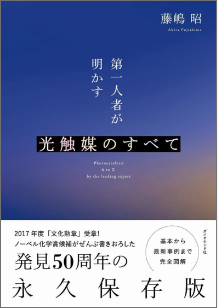
-
Photocatalysis A to Z by the Leading Expert, written by Professor Fujishima
-
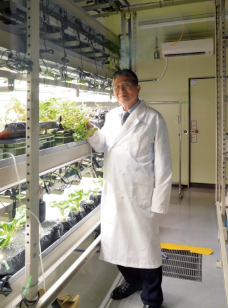
-
At a plant factory of the Photocatalysis International Research Center (2018)
Essential research partnerships between industry and academia to solve real-world problems
Hasebe:You have also taken the initiative in forging a partnership between industry and academia as early as your time at the University of Tokyo. In those days, perhaps you came under criticism from conservatives.
Fujishima: I believe research is useless unless it tangibly serves our society. Publication of papers is not enough. I would waste no opportunities in proposing joint research with willing companies to commercially apply technologies. Criticism didn’t really bother me. In any case, even after the commercial application, only a few products gain popularity.
My research is always aimed at helping people to live out a natural life span. That life span is now said to be 120 years. For people to live that long, a supply of clean energy, air, and water is essential. In this context, I find it rewarding to study photocatalysis to curb bacteria and bring more benefits to people and the environment.
Hasebe:YNU also believes that partnerships between industry and academia are vital. What are the keys to encouraging companies to partner with universities?
Fujishima:First of all, the technologies must be genuine. After all, companies cannot commit to ideas that would put them in the red. They need to make sizable impacts. That’s why it is vital to feel: “Oh, this is it! This can be put to real use!” To do so, we always need to get the solid basics in place, take interest in everything, and be on the lookout.
Hasebe:You seem to be extremely adept at networking with manufacturers.
Fujishima:Gaining understanding from researchers through discussion is not enough for commercially applying technologies. We need skills to directly convince the top management and executives with effective presentations. Understandably, the managers who assume the ultimate responsibilities are risk averse because their careers are at stake. According to my experience, my successes is usually down to gaining the understanding of the presidents of topnotch companies who assumed the responsibilities for their commitment.
Hasebe:That points to the importance of convincing the top management. Under the lead of its Research Initiatives and Promotion Organization, YNU has been discussing the vision for our partnership with companies over the long term, such as five or ten years. In the process, we have more occasions for discussion with the chief technology officers and other top management members from major companies. We present research that can grow into new industries or provide seeds for commercial application and hope to meet the needs of companies.
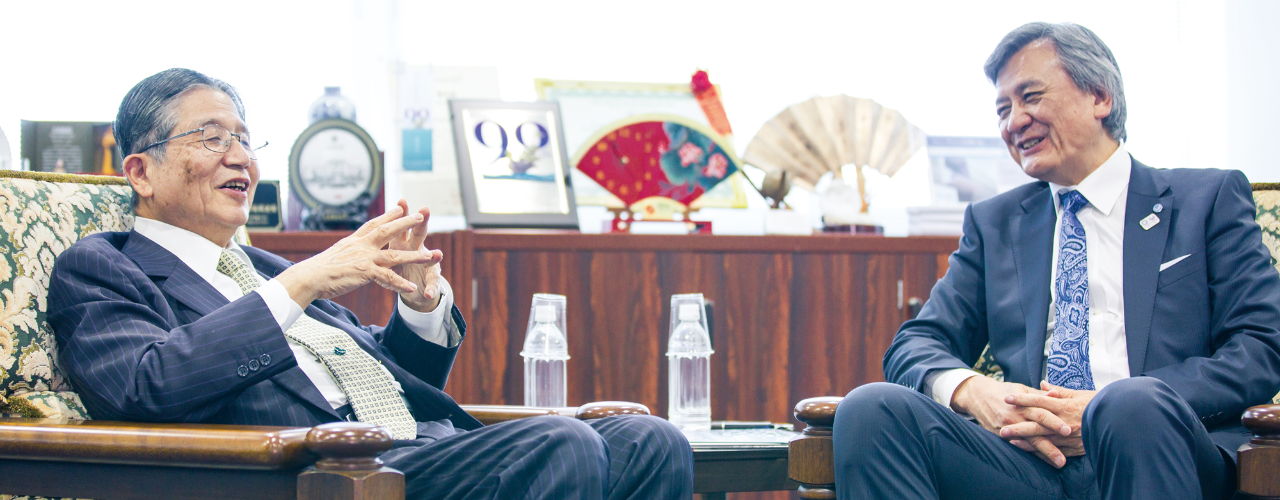
Seizing opportunities through international exchanges in both directions
Hasebe: Under the vision of the university of global excellence, YNU strives to serve both local and global communities as an international hub of practical studies to usher in a sustainable society. Global talents cannot be nurtured by language programs alone. Students also need programs to acquire the ability to think and communicate globally, and to develop qualities like intercultural skills and independence.
You began to promote international student exchange ahead of the times. How did it all begin?
Fujishima:Like other professors at the University of Tokyo, I could appoint associate professors and assistants myself. Because I appointed several Americans, the communication in our laboratory was primarily in English.
Hasebe:Probably not many professors appointed foreigners as associate professors or assistants. I see that you had already began to internationalize the faculty.
Fujishima:My laboratory invited students from many parts of the world, including India, China, South Korea, Romania, and other European countries. About 40 students came from China, among whom returnees with doctoral degrees are shining even today. One of my former students became a professor in his mid-thirties back at Peking University thanks to the timely system of appointing junior associate professors who returned from studies outside China as professors. Three other former students of mine were awarded the greatest scientific title in China to become academicians (i.e., members) of the Chinese Academy of Sciences.
Hasebe:You are also one of the few foreign academicians there, aren’t you?
Fujishima: I believe I am the first Japanese to be recognized as an academician at the Chinese Academy of Sciences. During my time as the second director of the China Research and Communication Center of the Japan Science and Technology Agency (JST), eight of my former students who are eminent in China kindly issued a booklet entitled "Fateful Encounter with a Teacher — Gifted Chinese Scientists from Fujishima Laboratory." In this academic year, 2018, I will have visited China about five times to deepen the exchange in science and technology between China and Japan.
Hasebe: I often meet you at New Year parties hosted by the Education Section at the Embassy of the People’s Republic of China in Japan. I am always impressed by the genuine respect you receive from faculty members of Chinese universities.
Over the past 20 years of my teaching career in the College of Economics, I also noticed a visible increase in the number of exchange students from countries like Indonesia, Nepal and China. The increase seems to have had a positive influence on Japanese students as they had more occasion to read papers and make presentations in English. They also gained more understanding of the unique situations of the home countries of their fellow students after detailed studies and analysis of economies like Indonesia and Nepal. In this manner, students should be encouraged to gain more nuanced perspectives of the world through a wider and deeper exchange with international students.
In 2017, YNU accepted over a thousand international students, which accounts for more than 10 percent of the total of about 10,000 enrolled students. We intend to accept even more international students and encourage Japanese students to study abroad, whether short- or long-term.
Fujishima:When Japanese students act as facilitators for international students, they spend a lot of time arranging meals together, escorting their foreign peers from and to hotels, and so on. During this time spent together, they become close friends. In international exchange, the key is exchange of students in both directions to build lasting relationships. The idea of sending facilitators to the countries of their fellow students should also be put into practice on a larger scale. Opportunities for international exchange broaden as students are given occasions to make friends from other countries, and thereby feel more at ease in pursuing studies abroad.
The Photocatalysis International Research Center at Tokyo University of Science, where I serve as the director, annually hosts a few dozen international students mainly from Asia. Students from different countries have deepened their exchange through joint research, dinner parties, and so on. Thanks to the positive influence from their foreign peers, Japanese students venture overseas more often. I am very glad to see the widening global network through the study of photocatalysis.
Hasebe:As one of the initiatives to promote international exchange, our College of Economics has been conducting a program called Euro-Japan Dialogue since 2006, and more recently Asia Dialogue with China. YNU sends students to our European partner institutions, but with Beijing Normal University, the exchange takes place in both directions. First, our students participate in discussions conducted in Beijing. Half a year later, we invite Chinese students to Yokohama to have them listen to our lectures and take company tours. On the last day, Chinese and Japanese students present their research findings in an English discussion session. The College of Business Administration runs a similar program.
Japanese students tend to have an aversion to communicating in English and they seem awkward at first. But that changes after preparing for and participating in theme-specific discussions on topics such as nuclear power plants, ageing society, welfare, and other issues. They gain confidence and begin to notice that the idea they want to convey is the most important element and that slight mistakes in English do not really matter. I believe the most effective ways to expand future opportunities for students are to help them overcome their hesitation to communicate in English, and, as Professor Fujishima says, to help them make friends from other countries.
I would like students to understand that they can seize opportunities by going on an international exchange, rather than waiting for the world to come to them.
-
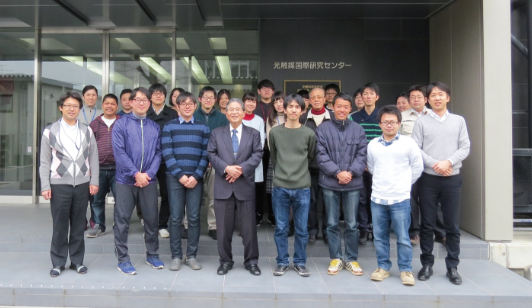
-
Prof. Fujishima (center), along with the members of Photocatalysis International Research Center (2016)
-
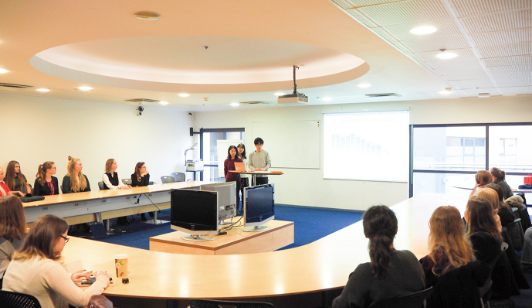
-
Euro-Japan Dialogue at University of Tallinn, Estonia (2017)
Professor Fujishima as described by his fellow alumni
-
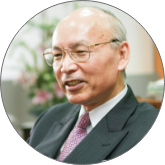
-
Masuo Aizawa (Class of 1966, Department of Electrochemistry, College of Engineering, Yokohama National University) is the Counselor to the President, Japan Science and Technology Agency, and Professor Emeritus and Former President of the Tokyo Institute of Technology.
My first contact with my dear fellow Akira Fujishima dates back to our admission to the Department of Electrochemistry at the College of Engineering. During our student years, we didn’t have any particularly memorable experiences together. But I fondly remember the time we discussed our future, wondering where to conduct our graduate research and what to do about our graduate studies. We later advanced to different graduate schools to venture into new realms like photoelectrochemistry and bioelectrochemistry. Long after our days together at YNU, we found ourselves taking the lead in new frontiers in electrochemistry. I will never forget the pleasure I had with him writing a two-volume textbook titled Electrochemical Measurement Methods (published by Gihodo Shuppan), which is still a brisk seller. It was also unusual that we both served as the presidents of the Electrochemical Society of Japan in succession. Our bond grows deeper as our paths are intertwined ever closer. I am sure I am not alone in hoping that he continues to add to the list of his numerous honors.
-
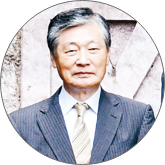
-
Seiichi Inoue (Class of 1966, Department of Applied Chemistry, College of Engineering, Yokohama National University) is the Chair of Meikyo Shizen Society (alumni association of colleges of science and engineering) , and Professor Emeritus of YNU and the Chairman of the Yokohama Kogyokai.
When Mr. Fujishima was studying at YNU back in the early 1960s, the College of Engineering was earnestly trying to catch up and overtake established universities and to establish its own graduate programs. In addition to specialized courses, the faculty was putting a lot of effort into enhancing the quality of basic engineering courses and graduation work. Having laid his foundation in electrochemistry in such an environment, Mr. Fujishima would later make a revolutionary discovery during his doctoral study at the University of Tokyo. We fellow alumni and YNU were so proud of him when the Emperor of Japan awarded him the Order of Culture, half a century after that discovery. In hindsight, it all owes to his outstanding curiosity and initiative. He still teaches at YNU.

